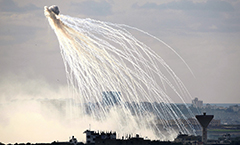Incendiary Bombs
Incendiary bombs are weapons designed to start fires or destroy sensitive equipment using fire, that use materials such as napalm, thermite, magnesium powder, chlorine trifluoride, or white phosphorus. Though colloquially often known as bombs, they are not explosives but in fact are designed to slow the process of chemical reactions and use ignition rather than detonation to start and or maintain the reaction. Napalm for example, is petroleum especially thickened with certain chemicals into a 'gel' to slow, but not stop, combustion, releasing energy over a longer time than an explosive device. In the case of napalm, the gel adheres to surfaces and resists suppression.
Incendiary bombs, filled with highly combustible chemicals such as magnesium, phosphorus or petroleum jelly (napalm), were dropped in clusters to spread fires. In the later stages of the Second World War they were employed by the Royal Air Force to create firestorms in places such as Dresden. The United States Army Air Force also used them extensively on cities such as Tokyo where there was a large number of buildings made of wood.
Incendiary bombs are of two main types. The burning material of the intensive type is thermite, a mixture of aluminum powder and iron oxide that burns at a very high temperature. The casing of such a bomb is composed of magnesium, a metal that itself burns at a high temperature when ignited by thermite. Intensive-type incendiaries are designed to set buildings afire by their intense heat. The other type of incendiary bomb is a thin-walled container of napalm, or jellied gasoline, that is used against personnel, vehicles, and flammable installations. The napalm spreads over a wide area, sticks to whatever it falls upon, and burns for a long time. Modern mixtures of napalm consist of gasoline, benzene, and a polystyrene thickener. More details
Incendiary bombs, filled with highly combustible chemicals such as magnesium, phosphorus or petroleum jelly (napalm), were dropped in clusters to spread fires. In the later stages of the Second World War they were employed by the Royal Air Force to create firestorms in places such as Dresden. The United States Army Air Force also used them extensively on cities such as Tokyo where there was a large number of buildings made of wood.
Incendiary bombs are of two main types. The burning material of the intensive type is thermite, a mixture of aluminum powder and iron oxide that burns at a very high temperature. The casing of such a bomb is composed of magnesium, a metal that itself burns at a high temperature when ignited by thermite. Intensive-type incendiaries are designed to set buildings afire by their intense heat. The other type of incendiary bomb is a thin-walled container of napalm, or jellied gasoline, that is used against personnel, vehicles, and flammable installations. The napalm spreads over a wide area, sticks to whatever it falls upon, and burns for a long time. Modern mixtures of napalm consist of gasoline, benzene, and a polystyrene thickener. More details

